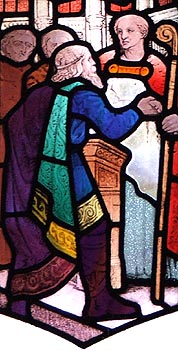
EBK Home
Kingdoms
Royalty
Saints
Pedigrees
Archaeology
King Arthur
Adversaries
Mail David
 Edmund the Magnificent,
Edmund the Magnificent,King of the English
(AD 921-946)
Edmund the Magnificent was the eldest son of King Edward the Elder by his third wife, Edgith. At the age of only sixteen, he fought valiantly alongside his elder half-brother, King Aethelstan in AD 937. Together they expelled the ruling Norse from Northern England at the Battle of Brunanburgh. Edmund was therefore the first King to inherit a united England upon Aethelstan’s death two years later. Soon after, however, Olaf Guthrithson retook York, apparently without opposition and, the following year, raided throughout the Midlands. Edmund marched North and besieged King Olaf and Archbishop Wulfstan of York in Leicester. Eventually Wulfstan and the Archbishop of Canterbury negotiated a peace treaty whereby the border between York and Wessex was set at Watling Street.
When Olaf Guthfrithson was killed raiding northern Northumbria in AD 941, Edmund took advantage of the situation and moved north the following year to take the Five Boroughs of the East Midlands from his successor, Olaf Sigtryggson; whilst also crushing the Welsh revolt of King Idwal of Gwynedd. By AD 944, Edmund felt secure enough to move on York itself, where he expelled both Olaf Sigtryggson and his rival, Ragnall Guthfrithson. Olaf retired to Dublin. The following year, Edmund ravaged Strathclyde and killed its troublesome King, Donald mac Donald. He returned the Kingdom to its Scottish overlord, Malcolm I, thus recognising Northumbria as the northern limit of Anglo-Saxon England.
King Edmund was married twice. Firstly, soon after he came to the throne, to St. Aelfgith - a benefactress of Shaftesbury Abbey - who became the mother of Kings Edwig All-Fair and Edgar the Peacemaker. She died in AD 944 and the King soon remarried to Ethelflaed of Damerham, daughter of Ealdorman Aelfgar of Wiltshire, but there were no further children.
In AD 946, Edmund sent envoys to the French Court in order to negotiate the restoration of the exiled Prince Louis, who had been fostered by King Aethelstan. Unfortunately, however, the King was killed before any agreement could be reached and his successor, Edred, did not pursue the matter. The King’s death, on 26th May AD 946, was a great shock to everyone. While staying at Pucklechurch in Gloucestershire, a outlaw named Leofa was recognized amongst the Court. A struggle ensued and the King tried to intervene. He was stabbed in the stomach and died almost instantly. He was buried at Glastonbury were he had appointed St. Dunstan as Abbot only a few years before. Though the King was not a zealous supporter of the monastic reform movement, this was an important step which had allowed the holyman to introduce the new Benedictine Rule to England.
